An improved understanding of fracture networks can result in an improved selection of CO2 storage locations and contribute to mitigating leakage risk.
The first part of the visit was spent looking at rock fractures in the vast extents of northern Patagonia. The second part took place at Y-TEC, the research centre of the national oil company YPF, and the technical university of La Plata (UTN). This visit was conducted through the NCCS Mobility Programme and the EU project DISCO2 Store.Understanding rock fracture networks is crucial for selecting CO2 storage locations
Porous rocks at depth are the ideal place to sequester CO2 and rapidly counteract anthropogenic emissions spiraling out of control. However, even deep underground, rocks seldom come as homogeneous and intact units, but rather as disjointed and fractured assemblies. Looking and studying the rock masses emerging above ground allows scientists to map, explore and consequently understand how these fractures conduct fluids from place to place. The worry for CO2 storage is of course that such fractures would amount to a high-speed leakage path out of the intended storage site. A better understanding and characterisation of such fracture networks will lead to informed selection of storage locations. It may also lead to targeted development of mitigation technologies.
Looking from afar and close at rock discontinuities is very helpful for any scientist trying to establish models, especially numerical simulations. In the case of SINTEF’s work in the “CO2 storage site containment” task (Task 10) of the Norwegian CCS Research Centre (NCCS), this is of prime interest for the work done on fault activation (development and propagation of shear fractures) and annular fractures around the well. For instance, when designing simplified geomechanical modelling of fault reactivation: what geometry should be input? What is the detail and extent of fracture zone to take into account? What properties are important to explicitly model? What amount of upscaling should be undertaken? Upscaling is a very useful technique whereby one steps back and lumps the effects of highly intricate small-scale heterogeneities into a uniform material, having some sort of average properties taken from the individual component materials.
CCS in Latin America
In 2023, SINTEF Research Manager Ane Elisabet Lothe and I visited Y-TEC, a research centre in Argentina, jointly owned by YPF, Argentina’s national oil company, and CONICET, its Research Council in La Plata near Buenos Aires. Both SINTEF and YTEC are partners in the EU project DISCO2 Store, a Marie Curie project based on secondments of scientists between EEA countries and Argentina and Chile.
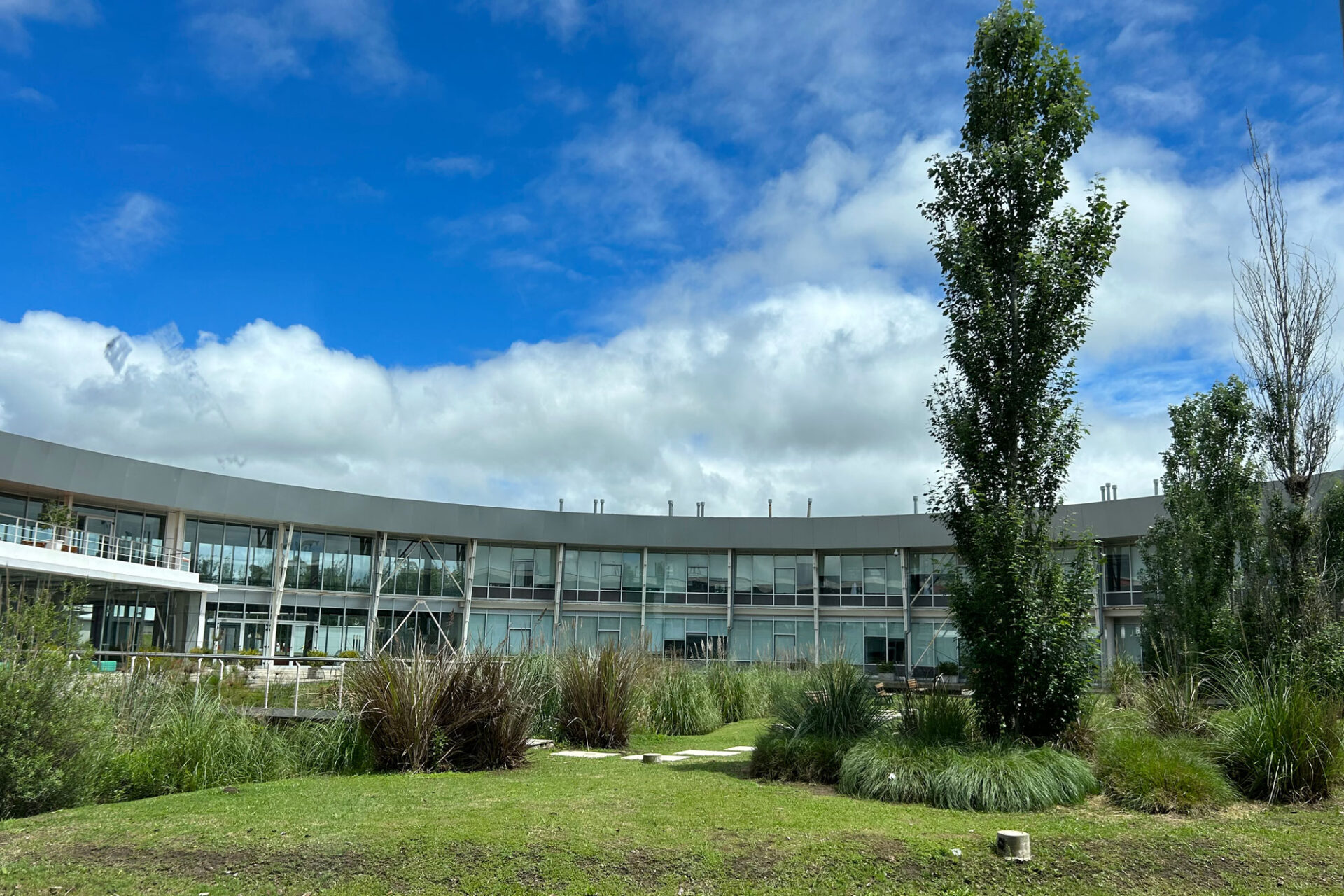
While the main theme of DISCO2 Store is to better understand fractures in rocks and their effect on CO2 storage, an underlying consequence is exposing Latin America to CCS. Here, SINTEF plays a leading role, with a majority of secondees coming to Trondheim and spending between one and three months at the Applied Geoscience department. “Secondees” refers to visiting scientists, either PhD students or experienced researchers, from another institution. The visits are organized in the framework of the project’s defined work packages but are really there to encourage free exchange between scientists and lead to cultivating further common interests.
Both Ane and myself are work package leaders in the DISCO2 Store project, and in SINTEF, are project managers on pore fluid pressure prediction from geological modelling and rock mechanics applied to CO2 and hydrogen underground storage, respectively. We have also actively participated in shaping and working in the storage activities of NCCS, led by SINTEF, which covers the whole CO2 chain, from capture through transport and storage.
Mohammad Masoudi, postdoc from UiO in SINTEF’s Hystorm project, also spent three months at Y-TEC, working with physicists on experiments and modelling of fluid displacement in model fractures. This is highly relevant for both CO2 and hydrogen, where it is important to understand to what extent the fluids may displace resident brine in fractures.
The DISCO2 Store project manager, Alain Zanella from Le Mans Université, led the geological field trip. He has been mapping the faults and formations in the Neuquén province since 2010. Besides the Norwegian delegation, three geologists from Y-TEC joined the expedition (Augusto Varella, Remi Ruiz and Mariano Arregui).
Field trip to Neuquén
The field trip started with a flight from Buenos Aires to Neuquén, the Stavanger of Argentina (its own oil city). It is the capital of the province with same name, the gateway to Patagonia and where ongoing oil and gas production is concentrated onshore Argentina. Production is mainly from the tight Vaca Muerta shale, through hydraulic fracturing. The same formation and other shale layers will also be scrutinized as seals for underlying CO2 storage, when Argentina matures to this new, green transition technology.
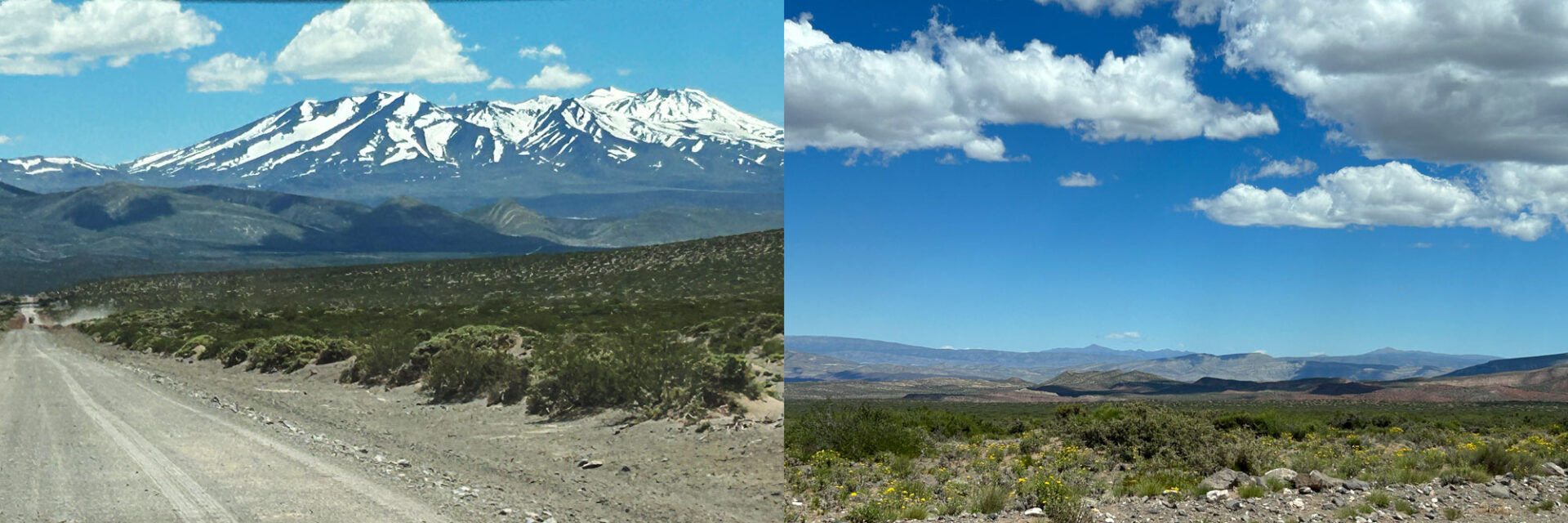
A first stop was made close to Chos Malal, where a bitumen mine was visited. Chos Malal is a charming small locality north in the province, near the Chilean border. It serves as a base for hikers and bikers and is situated along the mythical route 40 crossing Argentina from north to south.
Established by the first nation population of the area, the mine served to produce bitumen as combustible for cooking needs. The mine is an open pit excavation that follows a rectilinear fracture, originating from close to a today inactive volcano over a distance of several kilometers. The fracture has an opening of 10 meters at its closest to the volcano, reducing to 3 meters downstream. It is an unsolved mystery in terms of its origin, as it suggests lateral migration of bitumen under high temperature, leading to hydraulic fracturing of gigantic scale. Rock inclusions testify to the sheer magnitude of the force of the bitumen’s flow.
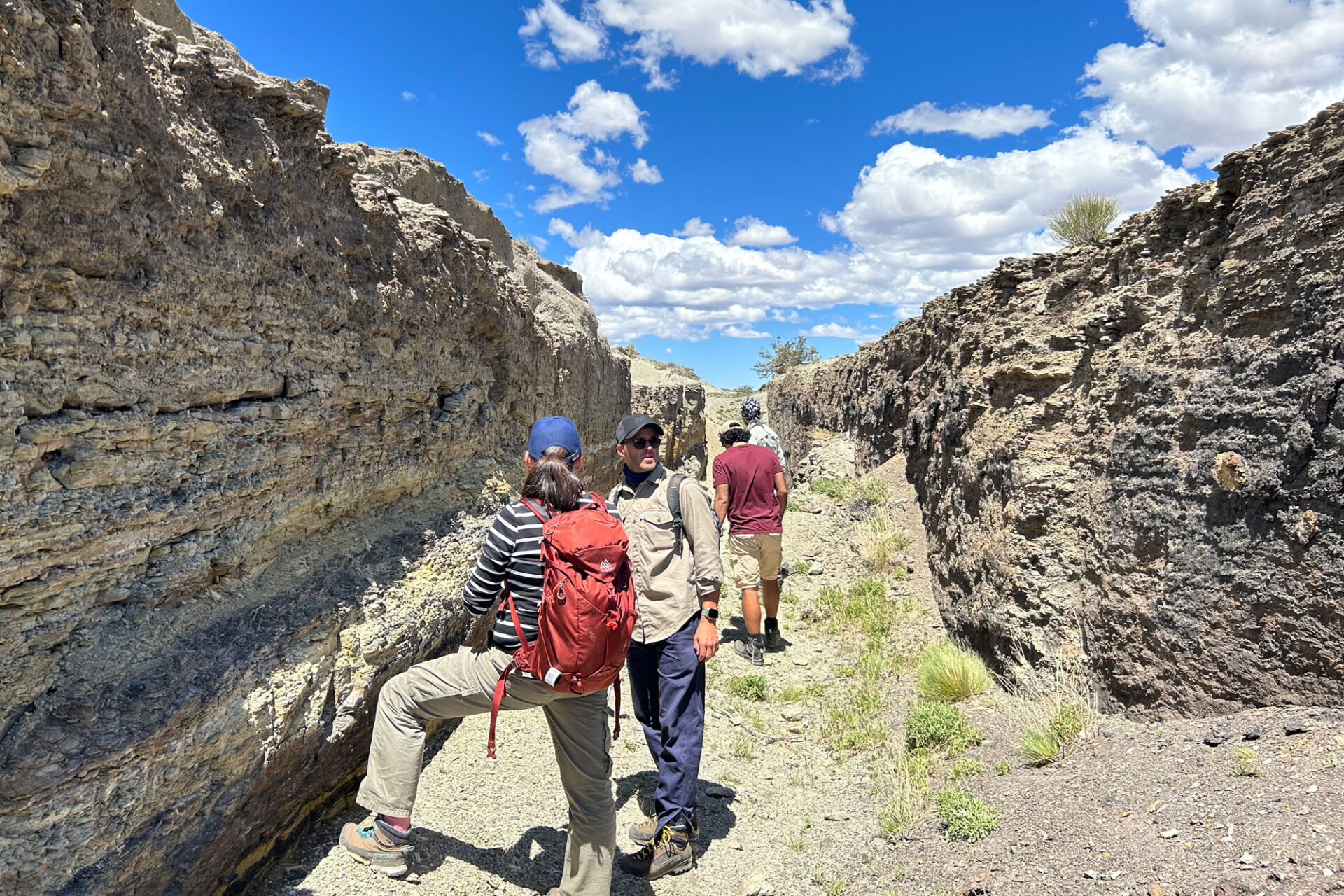
At a road cut, a thrust fault was admired, where large-scale deformation of sequences of alternating sandstone and shale occurs in its vicinity. This triggered a discussion on how best to model such faults, where clearly a discontinuity is not enough. However, how much detail is necessary to predict the permeability along the fault and its complex deformation area? Is it needed to fully characterize all the individual components both petrophysically and mechanically? The importance of trace fossil networks was highlighted, as these could be shown to occur both in the permeable sandstone and in the interlaying sealing shale, thus potentially transforming the complex structure from a seal to a leak. Do these features also appear in the North Sea? Would it constitute a threat for large-scale and long-term CO2 storage? It could be interesting to include an upscaled version of such complex systems in SINTEF’s conceptual fault model, developed in NCCS.
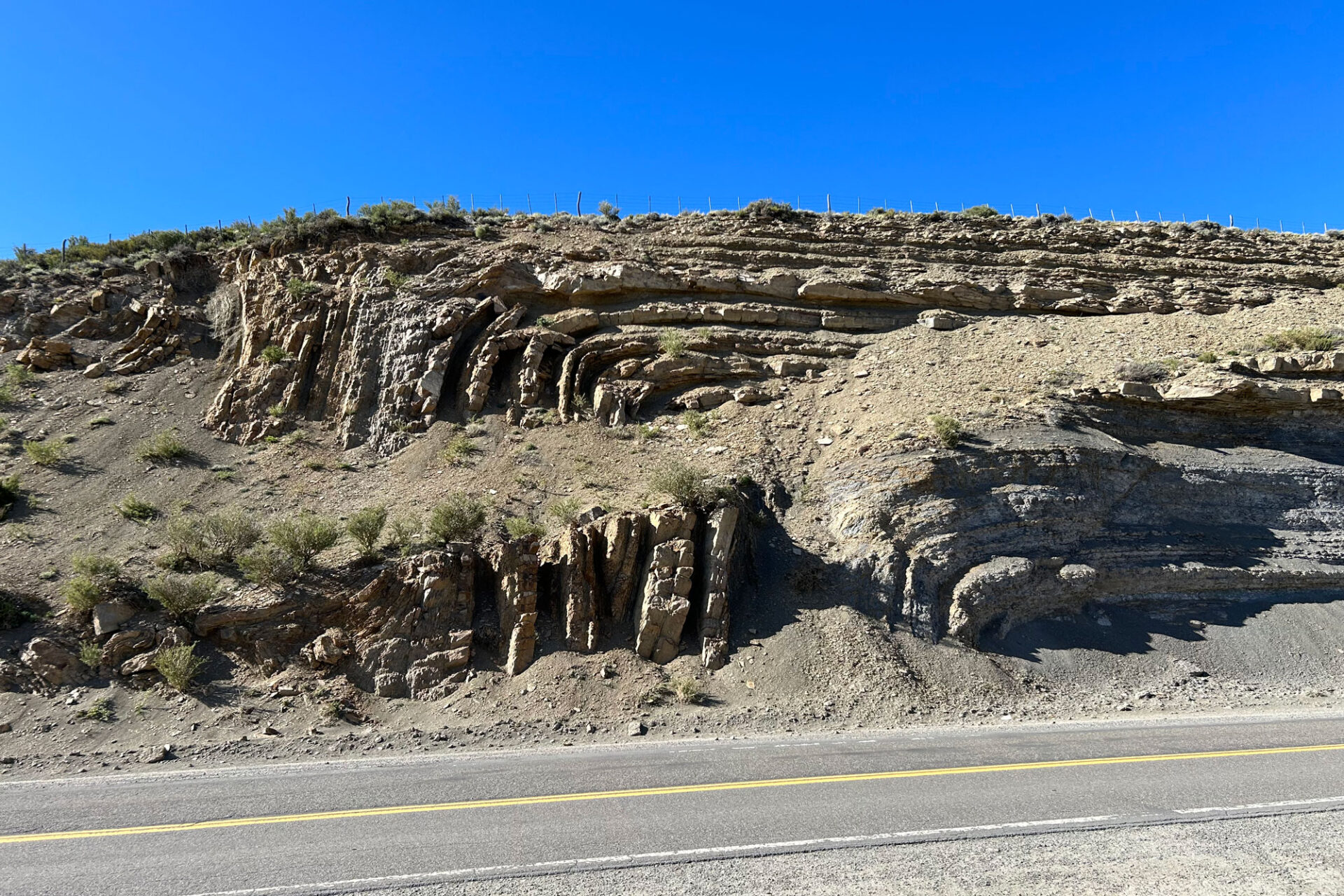
Fracture flow experiments and modeling, La Plata
After the field trip, we returned to La Plata in the Buenos Aires province, to Y-TEC and UTN, the technical university of La Plata. As part of investigating how to secure CO2 containment in the subsurface, and mitigate or remediate beginning leakages through fracture, which are potentially invisible from the surface, more knowledge is needed on the physics of the flow of two fluids in rock fractures. Therefore, SINTEF worked to recreate realistic fracture flow, where CO2 pushes the already present fluid, mostly brine, out of the fracture. In addition, Masoudi exchanged ideas on numerical simulation techniques with the colleagues from UTN, as he stayed in La Plata until mid-February 2024. UTN researchers also showed Masoudi their techniques for preparing rough plexiglass surfaces to mimic real fracture walls.
Hele-Shaw cells enable us to examine two-dimensional fluid flow
One accepted technique in the laboratory is the use of Hele-Shaw cells, which are basically the closest a scientist can get to examining two-dimensional fluid flow. A Hele-Shaw cell consists of two parallel glass or transparent plexiglass plates joined tightly together in order to leave a narrow regular space between them.
Fluid ports on the sides enable the space to be filled with one fluid, before displacing it with a second injected fluid. The cells are therefore good representations of fluid flow in a narrow fracture, albeit an idealized and simplified fracture, having regular geometry (no tortuosity or rugged sidewalls).
SINTEF researchers have previous experience with such laboratory contraptions, as has the geology department at UiO. These cells have been used in the past to study viscous fingering, where a lighter fluid displaces a thicker one. This results in an unstable front or border between the two fluids, which distorts and branches into long fingers of the displacing fluid rushing ahead of the displaced one.
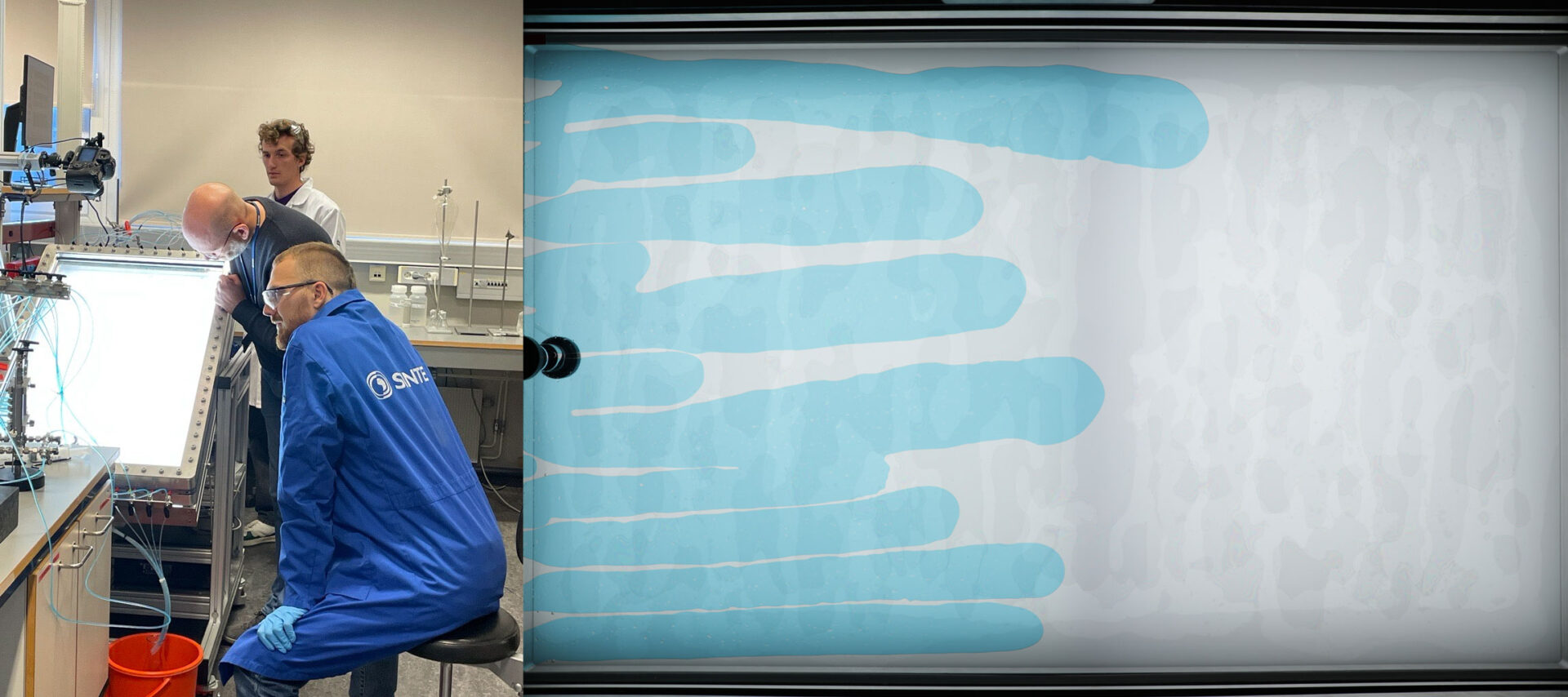
It is also common to fill the space between the parallel plates with sand, glass beads or other granular materials to study erosion-related phenomena. In the DISCO2 STORE Marie Curie EU project, a work package is dedicated to experiments with Hele-Shaw cells, where the recently developed versatile cell at SINTEF is to be utilized. This cell has the capability to be tilted in many directions, all the way from horizontal to vertical.

This then can help represent fracture flow between deposited formation layers, as observed in the Vaca Muerta formation, flow up an inclined fault, or flow up a fracture around a vertical well. In 2023, work preparing the cell for the first tests was jointly carried out by two tasks in NCCS, Task 10 and the “Reservoir management and EOR” task (Task 11). This is welcome help, as the Marie Curie project scheme only covers minimal expenses related to secondment travel, not project work.
As gases cannot be injected into the SINTEF Hele-Shaw cell, the strategy is to mimic brine displacement by CO2 by using two liquids presenting the same mobility ratio. Mobility is defined as the ease with which a fluid can be made to flow, and relates to its viscosity and its density. If the mobility ratio is greater than 1, the front between the fluids remains stable, that is, rectilinear. If the ratio is less than 1, the boundary deforms instantly and becomes unstable, with fingers of displacing fluid penetrating the displaced fluid.
While this scenario is true for immiscible fluids, CO2 dissolves in brine, which means the boundary between the two is a miscible front. Miscible displacement, for large enough initial front velocity, behaves in the same manner as immiscible displacement, but the boundary “thickens” with its travel along the cell or deformation. This will be repeated in UiO’s new Hele-Shaw cell, this time with CO2 gas displacing brine. The “truth”, aka the real situation in the subsurface, will be somewhere between the SINTEF and UiO cases.
In most planned storage sites, the CO2 injected will be in the supercritical state, that is at sufficiently high pressure and temperature that it is in a dense, liquid-like phase, but is also as light as a gas (low density and viscosity). This enables us to maximise the volume stored, as the same mass of CO2 takes much less place in dense form than it does in gas form. However, in a worst-case scenario, if the CO2 is allowed to climb up a fracture, it will come out of the solution or change phase and become gaseous again.
Investigating turbulent flow and backflow in hydraulically triggered rock fractures
Together with Y-TEC and UTN colleagues, Masoudi and I inspected the two large Hele-Shaw cells in La Plata. These are fixed-position cells, positioned vertically and with a relatively large gap between the plates, compared to the Norwegian cells. They were built, and are used, to principally investigate turbulent sand and proppant flow (and backflow) in a hydraulically triggered rock fracture.

Argentina’s onshore oil and gas adventure relies heavily on production from very tight shales, where the only means of extracting hydrocarbons is by fracturing the rock and letting the fluids flow back to the well through these highly permeable conduits. In order to keep the fracture walls open, sand or ceramic proppants are injected into the fractures. The cells are thus dimensioned for high flow rate experiments, and are probably not suitable for CO2/brine displacements at low flow rates. However, UTN also has a smaller cell, which postdoc Masoudi was able to use during his stay. An interesting feature of the cell at UTN, was their computer numerical control (CNC) lathe machined Plexiglas panes, which incorporate a superposition of undulations, created with two sinusoidal functions at different pitches. This introduces an effect of more realistic fracture wall roughness, or tortuous flow path between the plates.
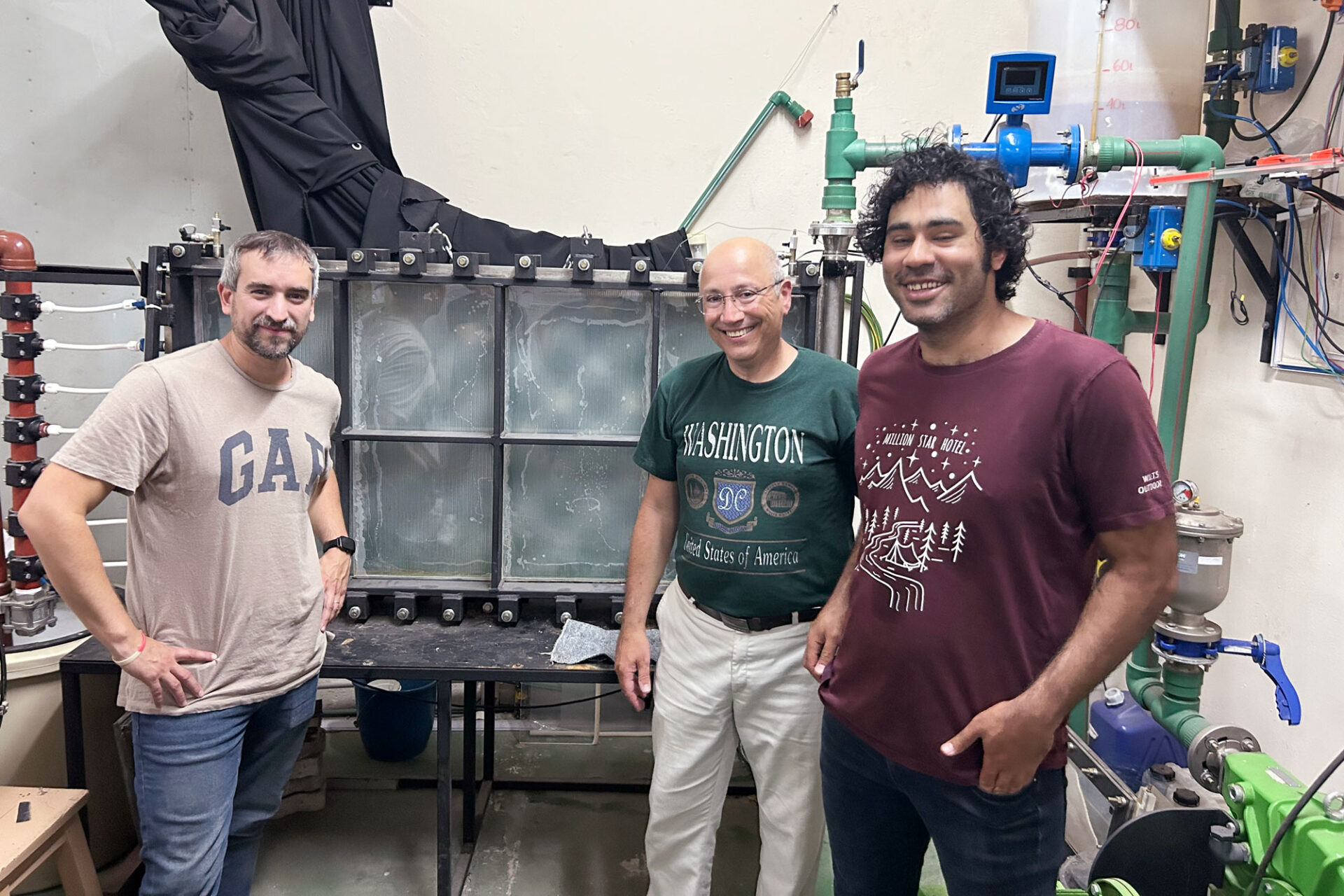
An exchange of expertise
Another activity that Masoudi was involved in was collaborating with the researchers at UTN on numerical modelling of the displacement experiments and diffusion propensity of CO2 and H2 into a shaley caprock. This was part of an exchange of expertise, wherein Masoudi learned how to utilize the Molecular Dynamics simulation method, while instructing Argentinian colleagues on Finite Element modelling.
Molecular Dynamics is a method by which one can really zoom in to a very small scale, introducing interaction laws between the molecules in the system. These laws govern interactions between different species, in our case the CO2 or H2 molecule and the clay platelet ions. The Finite Element method usually involves a larger scale and treats the fluids (in our case supercritical CO2 and brine) and solids as continuous matter, with for example macroscale properties such as density, viscosity, stiffness, etc.

Concrete research results after just one month
The Argentina mission was in our opinion very successful. It is seldom that a one-month stay generates concrete research results; however, the in-person contact with many collaborators is irreplaceable and will lead, no doubt, to very fruitful common work.
In terms of competence building, a keystone in many publicly funded research projects, these types of scientist mobility initiatives are very valuable. In our case, the combination of a geological field trip and stay at research facilities was particularly appreciated. There is no substitute for seeing the very complex rock masses and faults with the expert guidance of a geologist, which generated understanding and led to ideas on how to conduct bench-scale laboratory investigations as well as numerical models. Likewise, discussions and direct collaboration with scientists in Argentina enriches the research directions of all partners and spawns new ideas, seen from slightly different angles and origins.









Comments
No comments yet. Be the first to comment!